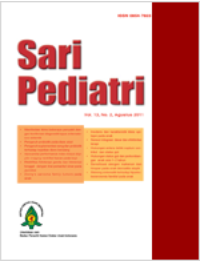Hubungan Mikroflora Usus pada Bayi Baru Lahir dengan Jenis Persalinan
Sari
Latar belakang.Mikroflora saluran cerna pada awal kehidupan berperan penting untuk respon imun dan dapat dipengaruhi oleh jenis persalinan.
Tujuan. Mengetahui hubungan antara jumlah koloni mikroflora usus Bifidobacterium, Lactobacillus, Clostridium, pada bayi baru lahir dengan
jenis persalinan.
Metode. Penelitian observasional analitik dengan pendekatan potong lintang terhadap semua bayi aterm sehat yang lahir pervaginam dan seksio
sesarea dari bulan Oktober 2013–November 2013 di Divisi Perinatologi Departemen Ilmu Kesehatan Anak (IKA) RSUP Prof. Dr. R.D. Kandou,
Manado. Dilakukan pemeriksaan tinja dengan quantitative realtime polymerase chain reaction (PCR-RT) untuk mendeteksi kolonisasi mikroflora
Bifidobacterium, Lactobacillus, dan Clostridium. Pengolahan data dengan uji Mann-Whitney.
Hasil. Dua puluh lima subjek bayi lahir pervaginam dan 25 subjek bayi lahir secara seksio. Terdapat perbedaan bermakna jumlah koloni Bifidobacterium
pada persalinan pervaginam (median 2,19 x 109 CFU/g) dibandingkan seksio sesarea (median 1,55 x 109 CFU/g) (p<0,001). Median koloni Lactobacillus
pada persalinan pervaginam 3,40 x 109 CFU/g tidak berbeda bermakna dengan seksio sesarea 3,51 x 109 CFU/g (p=0,362). Median koloni Clostridium
pada persalinan pervaginam 1,12x 109 CFU/g juga tidak berbeda bermakna dengan seksio sesarea 1,04 x 109 CFU/g (p=0,961).
Kesimpulan. Persalinan pervaginam kolonisasi mikroflora Bifidobacterium lebih tinggi dibandingkan dengan seksio sesarea. Tidak terdapat perbedaan
bermakna kolonisasi mikroflora Lactobacillus dan Clostridium pada persalinan pervaginam dan seksio sesarea
Kata Kunci
Teks Lengkap:
PDFReferensi
Guarner F, Malagelada JR. Gut flora in health and disease.
Lancet 2003;361:512-9
Rastall RA. Bacteria in the gut: friends and foes and how to
alter the balance. J Nutr 2004;134:2022-6
Evdokia K, Mitsou, Kirtzalidou E, Oikonomou I, Liosis
G, Kyriacou A. Fecal microflora of Greek healthy neonates.
Anaerob 2008;14:94-101.
Penders J, Thijs C, Vink C, Stelma F, Snijders B, Kumelling
I, dkk. Factors influencing the composition of the intestinal
microbiota in early infancy. Pediatrics 2006;118:511-21
Hutt P, Shchepetova J, Loivukene K, Kullisaar T, Mikelsaar
M. Antagonistic activity of probiotic lactobacilli and
bifidobacteria against entero and uropatogens. J Appl
Microbiol 2006:100:1324-32
Reuter G. The Lactobacillus and Bifidobacterium microflora of
the human intestine: composition and succession. Microbiol
;2:43-53.
Reyed RM. The role of Bifidobacteria in health. J Med Sci
;1:14-24.
Karlsson H, Hessle C, Rudin A. Innate immune responses
ofhuman neonatal cells to bacteria from the normal
gastrointestinalflora. Infect immun 2002;70:6688-96.
Dinkci N, Unal G, Akalin S, Gonc S. The importance of
probiotics in pediatrics. J Pakistan Nutr 2006;6:608-11.
Satokari RM, Vaughan EE, Akkermans AL, Saarela M, Vos
WM. Bifidobacterial diversity in human feces detected by
genus specific PCR and denaturing gradient gel electrophoresis.
Appl Environ Microbial 2005;67:504.
Dominguez-Bello MG, Costello, EK, Contreras M, Magris
M, Hidalgo G, Fierer N, Knight R. Delivery mode shapes
the acquisition and structure of initial microbiota across
multiple body habitats in newborns. Proc Natl Acad Sci USA
;107:11971-5
Yoshioka H, Iseki K, Fujita K. Development and differences of
intestinal flora in neonatal period in breast-fed and bottle-fed
infants. Pediatrics 1983;72:317-21.
Martin R, Soberon N, Vaneechoutte M, Florez AB,
Vasquez F, Suarez JE. Characterization of indigenous
vaginal Lactobacilli from health women as probiotic
candidates. Int Microbiol 2008;11:261-6.
Yang XL, Yang HX, Duan T, He J, Sum LZ, Yu TH.
Vaginal Microflora and relevant factors in puerperium.
Chin Med J 2009:Jul;447:496-9.
Irwanto EL, Yusrawati I, Jurnalis YD, Rasyid R, Machmud
R. Effect of spontaneous delivery and elective caesarean
section on number of Bifidobacterium colony in
newborns. Obstet Gynecol 2011 35: 49-52
Chen J, Cai W, Feng Y. Development of intestinal Bifidobacteria
and Lactobacilli in breast-fed neonates. Clin Nutr
Oct;26:559-66.
Penders J, Thijs C, Vink C, Stelma F, Snijders B, Kumelling
I, dkk. Quantification of Bifidobacterium spp. Eschericia coli
and Clostridium difficile in faecal samples of breastfed and
formula-fedinfants by real-time PCR. FEMS Microbiol
;243:141-7.
Alderberth I, Lindberg E, Abery N, Iriesselmar B, SaaIrnati
R, Strannergard IL, dkk. Reduced enterobacterial and
increased staphylococcal colonization of the infantile bowel:
an effect of hygienic lifestyle. Pediatr Res 2005;59:96-
Bennet R, North CE. Development of the fecal anaerobic
microflora after cesarean section and treatment with antibiotic
in new born infants. Infect 2000;15:332-6.
Lozo J, Vukasinovic M, Strahinic I, Topisirovic
L. Characterization andantimicrobial activity of
bacteriocin 217 produced by natural isolate lactobacillus
paracasei subsp. Paracasei BGBUK2-16. J Food Prot
;67:2727-34.
DOI: http://dx.doi.org/10.14238/sp17.1.2015.25-8
Refbacks
- Saat ini tidak ada refbacks.
##submission.copyrightStatement##
##submission.license.cc.by-nc-sa4.footer##
Email: editorial [at] saripediatri.org


Sari Pediatri diterbitkan oleh Badan Penerbit Ikatan Dokter Anak Indonesia
Ciptaan disebarluaskan di bawah Lisensi Creative Commons Atribusi-NonKomersial-BerbagiSerupa 4.0 Internasional.




